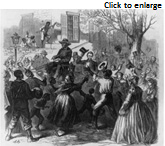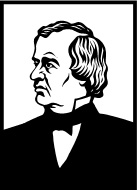
Interactive popup. Assistance may be required. made his views perfectly clear on how to handle an opponent who was knocked down. When Lincoln entered Richmond (the capital of the Confederacy) in the first week of April, 1865, he had a conversation with the Union general in charge of the city. Lincoln did not give orders on how to treat the people of Richmond, but he simply said, "If it were me, I'd let 'em up, let 'em up easy."
Lincoln's plan to readmit states into the Union is often referred to as the "Ten Percent Plan." This plan tried to treat the South fairly and bring the Union back together quickly.Interactive popup. Assistance may be required. to read the four points of the plan.

Lincoln had the opportunity to implement his lenient plan in a few states before he was assassinated. By the time John Wilkes Booth shot him while attending a play in Ford's Theater, Louisiana, Tennessee, and Arkansas had been reinstated to full union with the United States.

This period of Reconstruction is known as Presidential Reconstruction because these policies were dictated by the president using his commander-in-chief powers. Upon Lincoln's death, Vice President Andrew Johnson, a former Senator from Tennessee who remained loyal to the Union, continued Lincoln's policies with two major changes:
The stricter conditions reflected the anger of the North after the assassination of Lincoln. However, it was not nearly as tough as many people wanted. Johnson was not interested in punishing the South, but he was also not interested in protecting the civil rights of African Americans outside of ending slavery. Many former slaveowners would take advantage of Johnson's leniency.